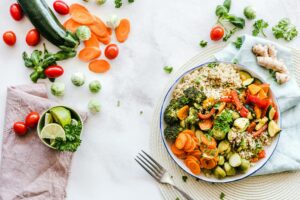When it comes to choosing healthier foods at the grocery store, learning to read nutrition labels can be your best tool.
Nutrition labels provide valuable information that helps you make informed choices, but they can sometimes feel overwhelming or complicated to interpret.
This guide breaks down the essential elements, so you can understand exactly what you’re consuming and make the best choices for your health.
Serving size: The foundation of the nutrition label
The first thing you’ll notice on a nutrition label is the serving size at the top. This is the reference point for all other nutritional information on the label. Pay attention here, because often the serving size is smaller than you might expect, and you may end up eating two or three servings without realizing it. The servings per container section tells you how many total servings are in the package.
When interpreting a label, remember that if you eat double the serving size, you’ll need to double all the other numbers on the label, like calories, fats, and sugars, as well.
Calories: The basic energy unit
Next, you’ll see the calorie count, which is the amount of energy in each serving. While not everyone needs to count calories, being mindful of them can help you gauge the food’s overall energy density.
Calories provide a general idea of how filling or energy-dense a food might be. For example, nutrient-dense foods like fruits, vegetables, and whole grains offer fewer calories but come with a high nutritional benefit. By contrast, highly processed or sugary foods may pack a lot of calories with limited nutrients.
Fats: Saturated, unsaturated, and trans fats
The total fat content listed on the label is typically broken down into saturated fat, trans fat, and sometimes unsaturated fat. Here’s what each type means:
- Saturated fat: Often found in animal products like meat, cheese, and butter. Consuming too much saturated fat can raise your LDL (or “bad”) cholesterol levels, which can increase your risk of heart disease.
- Unsaturated fat: Includes polyunsaturated and monounsaturated fats, typically found in plant-based oils, nuts, seeds, and fish. These fats are generally healthier and can be beneficial for heart health.
- Trans fat: Found in some processed and baked goods, trans fats can significantly raise LDL cholesterol and lower HDL (“good”) cholesterol, increasing heart disease risk. Many food labels will list “0g” of trans fat if the amount is below 0.5g, so check the ingredients list for words like “partially hydrogenated” to avoid trans fats completely.
Try to limit your intake of saturated and trans fats and prioritize healthy unsaturated fats whenever possible.
Cholesterol and sodium: Keeping an eye on heart health
High levels of cholesterol and sodium can impact heart health, so it’s wise to monitor these closely. Processed foods and packaged meals often contain high amounts of sodium for preservation, and over time, high sodium intake can contribute to high blood pressure and other cardiovascular issues.
According to dietary guidelines, a general daily limit for sodium is around 2,300 mg for most adults, though many people benefit from even lower amounts. Aim to choose foods with lower sodium and cholesterol levels to support heart health.
Carbohydrates: Fiber, sugars, and total carbs
The total carbohydrates section lists all carbohydrates in a serving, including dietary fiber and sugar, both of which are listed separately. Here’s what to consider:
- Dietary fiber: Fiber is essential for digestive health and helps maintain stable blood sugar levels. Foods high in fiber tend to keep you feeling full longer. The general recommendation is about 25–30 grams of fiber per day from whole foods.
- Sugars: This category lists all sugars, including both naturally occurring sugars (like in fruits) and added sugars. You’ll often see added sugars listed separately, which refer to any sugars added during processing. A lower number in added sugars is usually a healthier choice, as high added sugar intake is linked to weight gain, diabetes, and other health issues.
Protein: The building block of nutrition
Protein is an essential nutrient that supports muscle, skin, and immune health. Foods high in protein help keep you full longer and can be beneficial for overall health. While most people get enough protein, it’s worth checking that the foods you choose have adequate protein content, especially if you’re selecting plant-based or vegan options.
% Daily Value: A quick reference guide
The % Daily Value (% DV) is a tool to help you gauge how much of a nutrient one serving of food provides compared to the daily recommended intake. These values are based on a 2,000-calorie diet, so if your calorie needs are higher or lower, adjust accordingly. Here’s a quick guide on how to interpret % DV:
- 5% DV or less: Low in this nutrient
- 10%–20% DV: Moderate level of this nutrient
- 20% DV or more: High in this nutrient
For example, if you’re aiming to increase your fiber intake, a food with 20% DV or more for fiber would be a high-fiber choice. Similarly, foods with high % DV of sodium may be best in moderation.
Ingredients list: The hidden details
The ingredients list is where you’ll find what’s really in your food, and it’s especially helpful for spotting added sugars, artificial flavors, or preservatives. Ingredients are listed in order of quantity, so the first few ingredients make up the bulk of the product. If you’re aiming for a cleaner diet, look for shorter ingredients lists. These should include recognizable items and avoid foods with many artificial additives.
For example, if sugar appears in the top three ingredients, it’s likely that the product is high in added sugars, even if the front of the package markets it as “low in sugar” or “healthy.”
Avoiding common pitfalls and misleading labels
Food companies often use marketing phrases that can be misleading. Here’s what some common claims mean:
- “Natural”: This doesn’t mean organic or free of additives. Natural only means the food is minimally processed and doesn’t contain artificial flavors or synthetic substances.
- “No added sugar”: While this means no sugars were added, the product may still contain natural sugars, like in fruit or dairy.
- “Fat-free” or “low-fat”: Sometimes fat is replaced with sugar or other fillers to enhance flavor. Double-check the ingredients and total sugars to ensure you’re making a healthy choice.
In conclusion
Reading and understanding nutrition labels can be a valuable skill for making healthier choices at the grocery store.
By taking note of serving sizes, paying attention to % DV, and checking ingredient lists, you can better understand what’s in the foods you’re buying. You’ll also choose options that align with your health goals.
Over time, label reading will become second nature, helping you feel more confident in your food choices.
Kaia FIT is a women’s fitness and nutrition program that empowers women to become the best version of themselves through personalized coaching in a group environment. We prioritize community to help connect women to each other for additional support and accountability. Caren Roblin is the owner of Kaia FIT Sierra, with four studio locations in Reno-Sparks.




